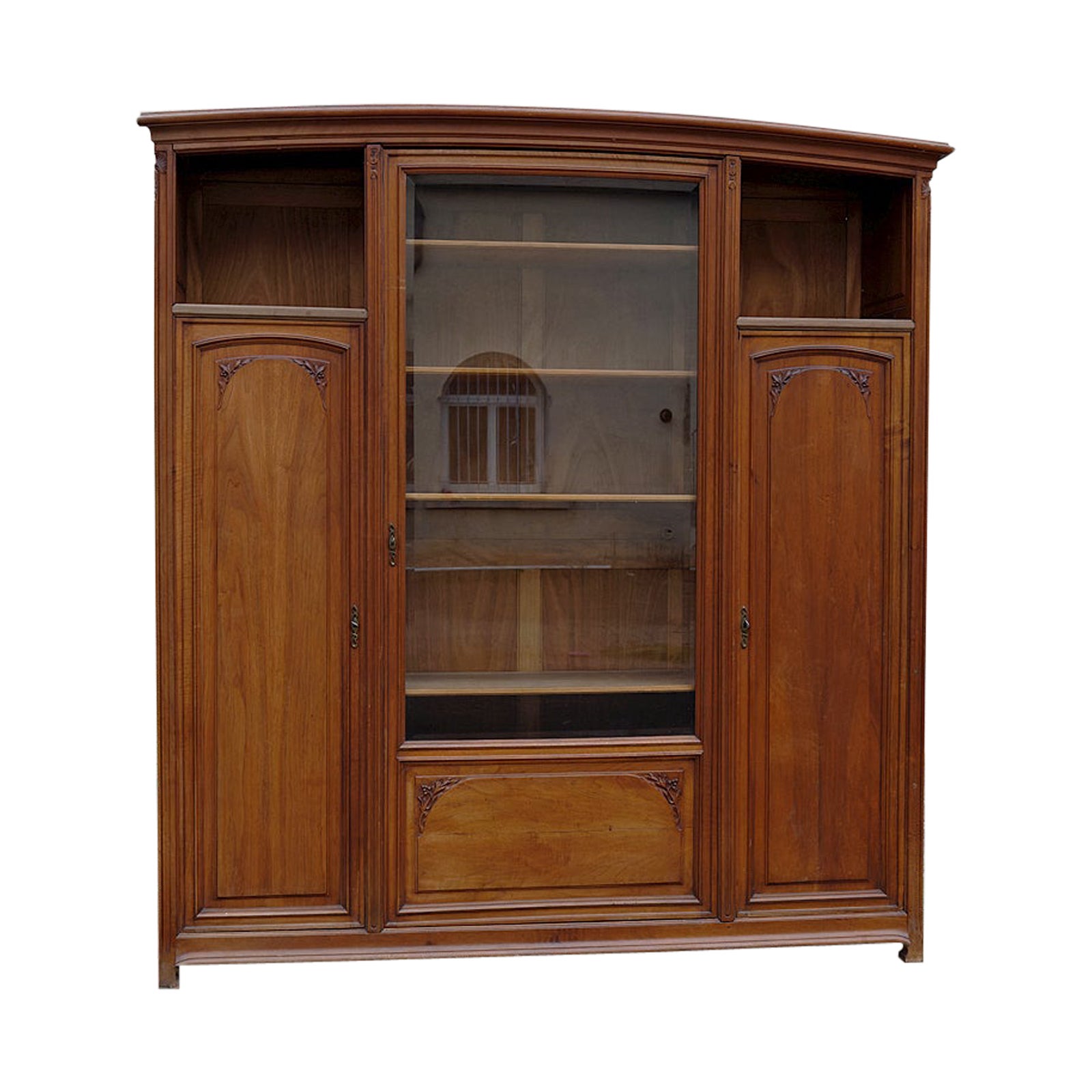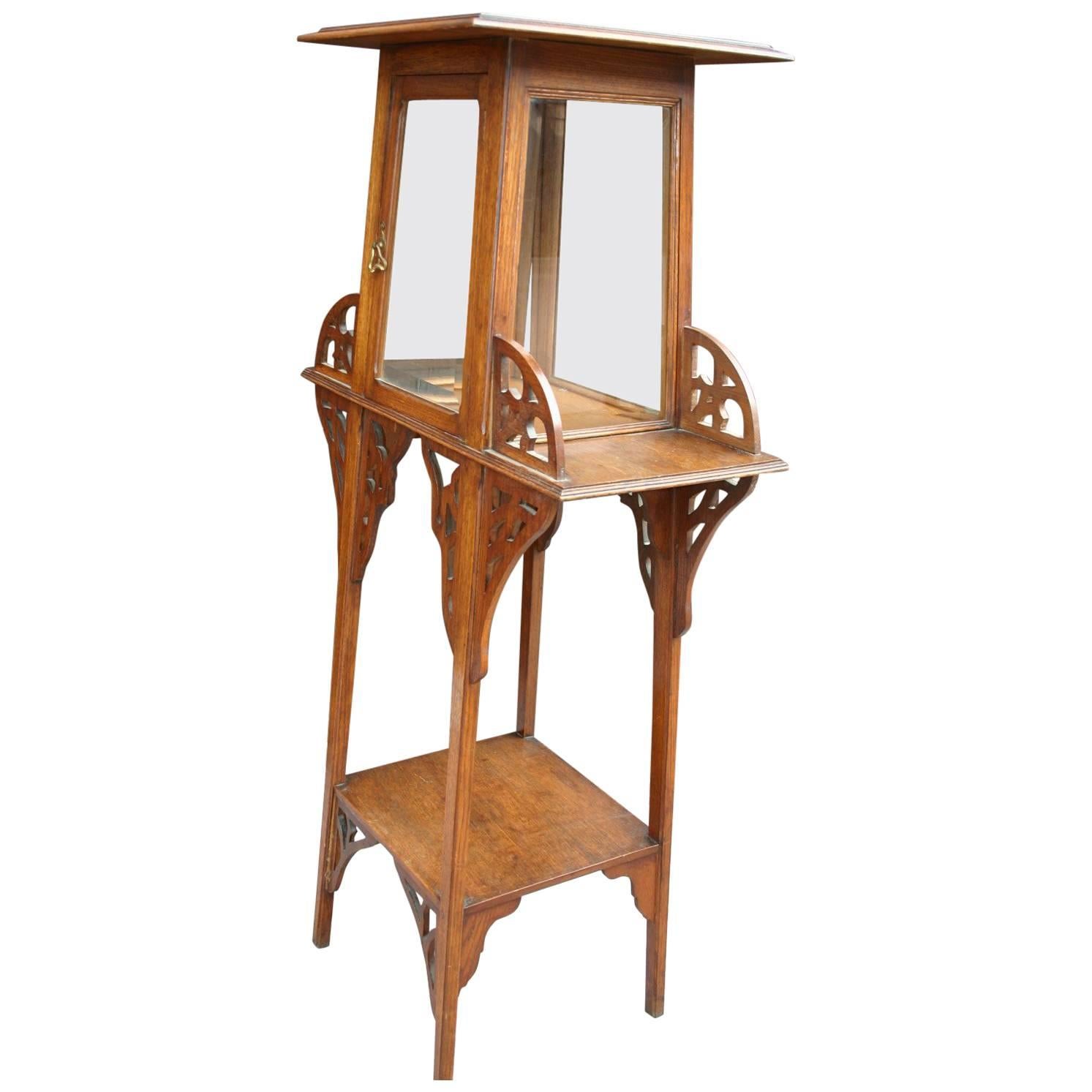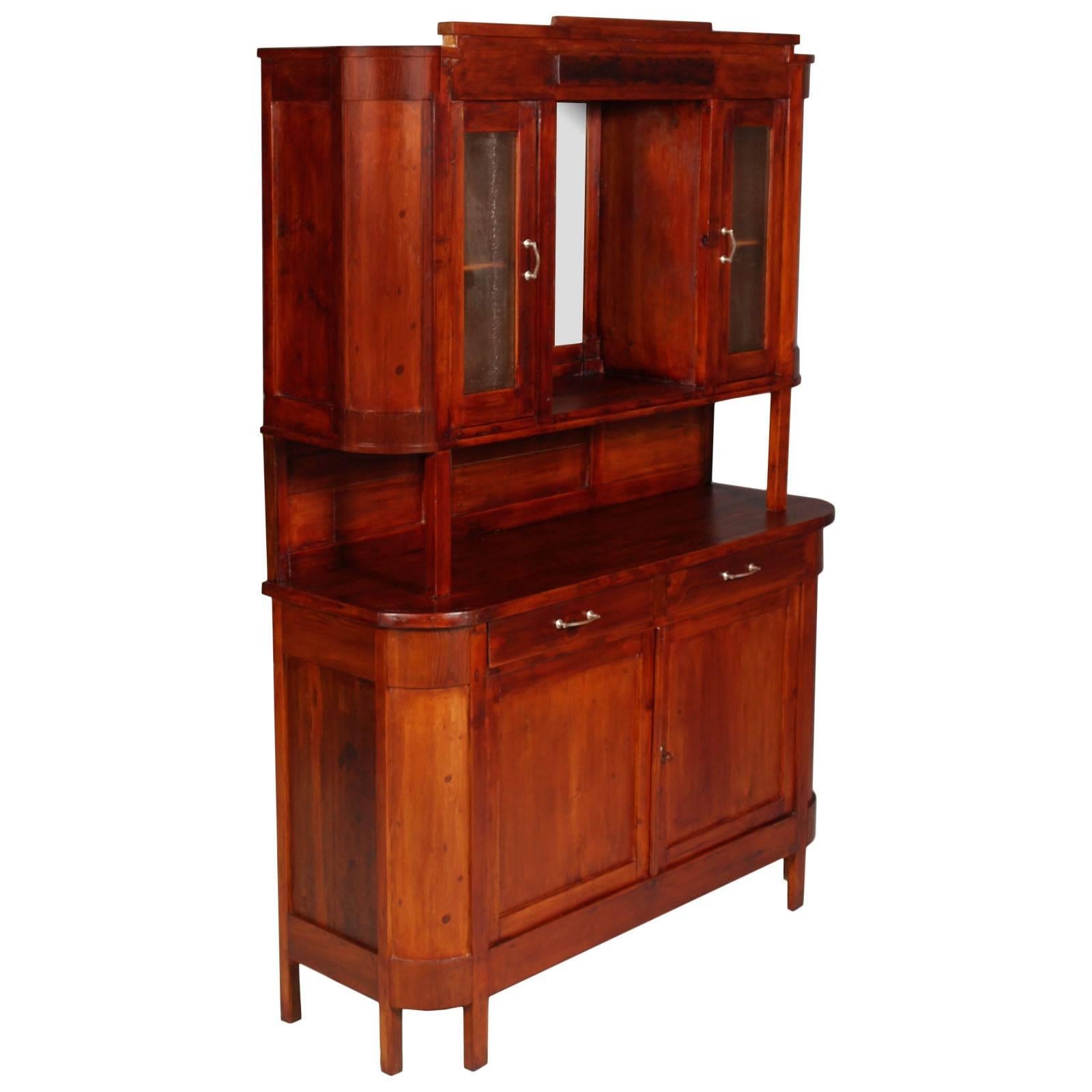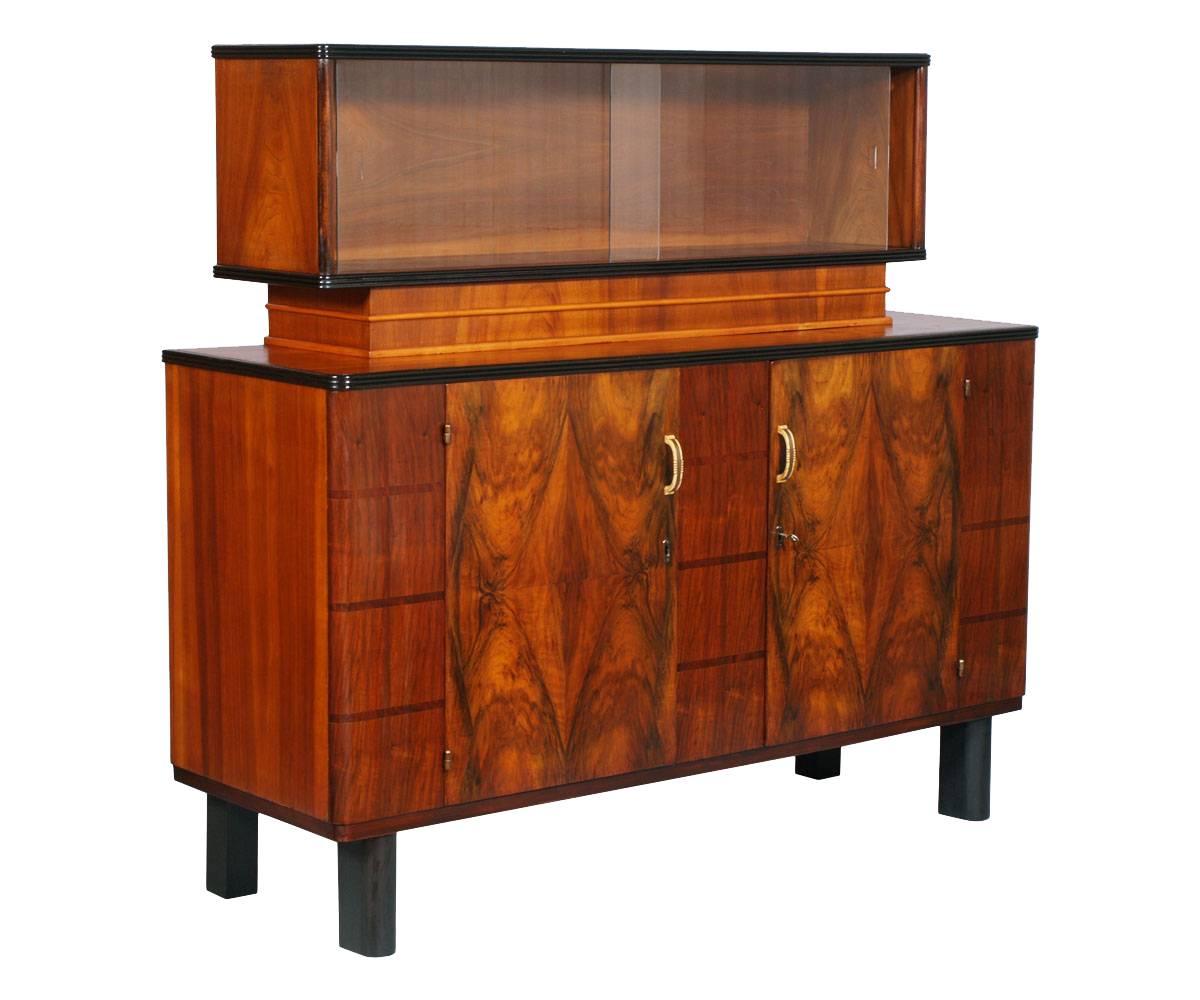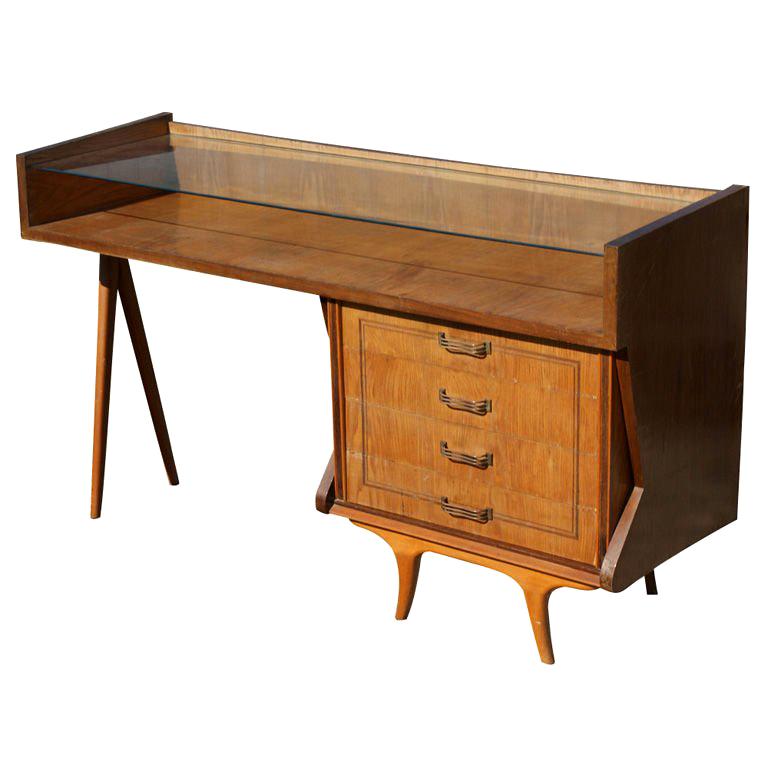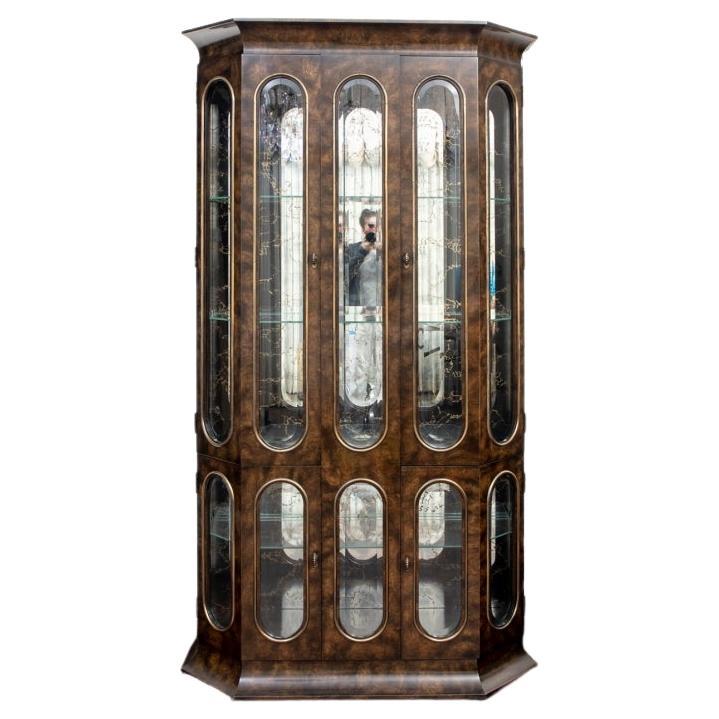Items Similar to Bespoke Burl Wooden Art Nouveau Display Glass Cabinet H. Pössenbacher Est. 1784
Want more images or videos?
Request additional images or videos from the seller
1 of 20
Bespoke Burl Wooden Art Nouveau Display Glass Cabinet H. Pössenbacher Est. 1784
About the Item
A bespoke diplay cabinet made by one of Munich´s most traditional cabinet makers Heinrich Pössenbacher in the early 1900 years (between 1908 and 1918)
The piece of furniture which is in incredibly good condition has been produced for a family in the Bogenhausen district of Munich and was part of set (a credenza 2 beside tables and a huge dining table with 6 chairs) which we´ve already sold.
The tables and chairs are now in an apartment in Schloss Schönbrunn in Vienna - the huge credenza in a noble house in Zehlendorf / Berlin)
This beauty which is still available is consisting of 2 pieces (upper display cabinet and base - both quite heavy ).
Veneered with finest walnut burl wood - Intarsia works with classic Jugendstil ornaments - lower base and legs artfully surrounded by a wooden trim.
These furniture are amongst the most beautiful and at highest standard artfully elaborated pieces I´ve ever have had the pleasure to own.
The unbelievably good condition is no doubt due to the fact that the pieces virtually never have been used as since the early 1960s they were standing in the living room of a farmstead which belongs to the heir a family member of the original owners - covered with blankets all those years. It was by lucky chance that after I had a long conversation with this gentleman just when I was about to leave it occurred to him that he forgot to tell me about the drawings... lucky me!
There has been carried out an artful drawing for each piece of furniture in order to give the client an idea how the pieces will be looking like. Of course I will include the drawing of the cabinet in a portfolio so the new owner will be free to frame it at his de-lite!
Pössenbacher artistic cabinetmakers have a tradition through 5 generations!
The history of Pössenbacher dates back to his great-great-grandfather Matthaeus Pössenbacher who created furniture for Architect François de Cuvilliés!
The company Pössenbacher was founded by Mathias Pössenbacher (son of Matthaeus and great-grandfather of Heinrich) in 1784.
Here a list of this incredible family:
Matthaeus Pössenbacher (nachweisbar in den 1770er Jahren), deutscher Möbelschreiner
Mathias Pössenbacher, deutscher Architekt
Joseph Pössenbacher (1799–1873), deutscher Möbelfabrikant, Hofschreiner
Anton Pössenbacher (1842–1920), deutscher Möbelfabrikant
Heinrich Pössenbacher (1877–1959), deutscher Möbelfabrikant
( I had a long research by contacting 2 experts from the Stadtmuseum München to find it all out - they would even have bought all pieces of this bespoke set if they had the space in their museum ! )
----****-------------------------****---------------------------------****------------------------------****------------------------------****----------------------------****---
(starting here: please use the 1stdibs translation software to translate in your language)
Heinrich Anton Josef Pössenbacher (* 3. Mai 1877 in München; † 10. August 1959) war ein führender deutscher Möbelfabrikant.
Leben
Der Sohn des Hofschreiners und Hofmöbelfabrikanten Anton Pössenbacher besuchte die Technische Hochschule München und trat dann in das Unternehmen seines Vaters ein.
„Bei einem Aufenthalt in England, der Pössenbachers Möbelstil nachhaltig beeinflusste, lernte er den Architekten John Archibald Campbell (1878–1947) kennen und bewegte ihn,
1901 als Entwerfer nach München zu kommen. 1902 erfolgte ein Umzug in neue, reich von Campbell ausgestattete Verkaufsräume an der Ecke Brienner Straße / Wittelsbacher Platz.“
Im selben Jahr übernahm Heinrich Pössenbacher von seinem Vater dessen Fabrik für Luxusmöbel, die er 1927 vergrößerte, indem er eine Maschinenhalle und eine neue Werkstätte
errichtete. Unter seiner Leitung führten die Pössenbacher Werkstätten repräsentative Aufträge aus, darunter Ausstattungen für die Dampfer Milwaukee (1928) und Europa (1929)
der Reederei Hapag Lloyd.
Im Rheinland geknüpfte Kontakte führten zur Ausführung von Innenausstattungen des Grandhotels Petersberg bei Königswinter (1914 und 1922)
– und 1920 zu seiner zweiten Ehe mit Emilie Mülhens, einer Tochter des Hotelbesitzers und Kölner Unternehmers Ferdinand Mülhens.
Die wirtschaftlichen Schwierigkeiten in der Zeit nach dem Ersten Weltkrieg führten 1925 zur Aufgabe der Verkaufsräume im Haus Brienner Straße 55.
Weltausstellung Paris 1937
In der Geschäftsleitung wurde Heinrich Pössenbacher sukzessive durch seine Söhne vertreten: Otto (* 1907) im kaufmännischen Bereich und Fritz (* 1906)
in künstlerischen Belangen. 1935 ließ sich Heinrich Pössenbacher ein stilvolles Landhaus in Berg am Starnberger See nach eigenen Plänen bauen.
Es waren nicht die direkten Zerstörungen des Zweiten Weltkriegs, die zum Ende des Traditionsunternehmens führten.
Obwohl Teile der Fabrikanlagen und das ganze Holzlager durch Bomben zerstört worden waren, wurde alles vollständig wiederaufgebaut.
Aber der Wegfall wichtiger Märkte im Bereich von Luxusausstattungen, die fortschreitende Serienfabrikation und die Vermehrung der Handwerksbetriebe ließ die Gewinne schmelzen,
so dass Heinrich Pössenbacher und seine beteiligten Söhne Fritz und Otto 1951 den Verkauf des Komplexes Jahnstraße 45 an die Elektrotechnische Fabrik Alois Zettler GmbH
beschlossen.
____________________________________________________________________________
Der Vater: Anton Pössenbacher (* 6. Oktober 1842 in München, Königreich Bayern; † 4. Juli 1920 in München, Freistaat Bayern) war ein führender Münchner Hofschreiner und Hofmöbelfabrikant im Stil des Historismus.
Anton Pössenbachers Vater Joseph Pössenbacher (1799–1873) hatte in München eine Möbelmanufaktur, die den bayrischen Königshof belieferte.
Die Werkstatt war von dessen Vater, dem Architekten Mathias Pössenbacher 1784 gegründet worden. Dessen Vater Matthaeus Pössenbacher (nachweisbar in den 1770er Jahren) stellte Möbel für den Münchner Architekten François de Cuvilliés her.
Pössenbacher besuchte die Königliche Kunstgewerbeschule München. Seine Lehrer waren u. a. H. Dyck und J. Knabl. Anschließend arbeitete er von 1860 bis 1863 in Wien,
Berlin, Köln, Paris und London als Schreiner und Zeichner. 1866 übernahm er die Schreiner-Gerechtsame seines Vaters um 10.000 Gulden und erwarb 1873
von einem Zimmermeister ein zwei Tagwerk großes Anwesen mit Wasserkraft in der Baumstraße 3 (später Jahnstraße 45) in München, welches er zu einer großen Möbelfabrik ausbaute.
Sein Unternehmen war im 19. Jahrhundert in der Fertigung von Luxusmöbeln europaweit führend. Insbesondere stattete er die königlichen Appartements der Schlösser Linderhof,
Herrenchiemsee und Neuschwanstein mit Möbeln aus, die nach den Wünschen König Ludwigs II., aber auch nach eigenen Zeichnungen schuf.
Auch für die Münchner Residenz und für die Burg Trausnitz fertigte er Einrichtungsgegenstände.
1886/87 möblierte er einen Bibliothekssaal im Bukarester Schloss für König Karl I. nach eigenen Entwürfen, den Restaurationssaal für das Reichstagsgebäude schuf er nach einem
Entwurf von Paul Wallot. Für weitere Auftraggeber wie Fabrikanten, Kaufleute und Gutsbesitzer lieferte er für deren Stadthäuser und Villen zumeist ganze Raumausstattungen.
Anton Pössenbacher erhielt den Titel eines Kgl. Hofmöbelfabrikanten und Kommerzienrates. Er setzte sich mit Gabriel von Seidl und dessen Jugendfreund Rudolf Seitz
für die Wiederbelebung des Renaissancestils ein.
Seine Möbelfabrik wurde von seinem Sohn Heinrich Pössenbacher übernommen.
- Attributed to:Moritz Ballin (Cabinetmaker)
- Dimensions:Height: 71.66 in (182 cm)Width: 67.33 in (171 cm)Depth: 23.23 in (59 cm)
- Style:Art Nouveau (Of the Period)
- Materials and Techniques:
- Place of Origin:
- Period:1910-1919
- Date of Manufacture:1908-1918
- Condition:
- Seller Location:Kumhausen, DE
- Reference Number:1stDibs: LU8587234300522
About the Seller
5.0
Gold Seller
These expertly vetted sellers are highly rated and consistently exceed customer expectations.
1stDibs seller since 2023
9 sales on 1stDibs
Typical response time: 2 hours
- ShippingRetrieving quote...Ships From: Bodenkirchen , Germany
- Return PolicyA return for this item may be initiated within 10 days of delivery.
More From This SellerView All
- Colli Torino (Est. 1850) Art Nouveau Italian Corner Cabinet Wardrobe Solid OakBy Colli TorinoLocated in Kumhausen, DEThis corner wardrobe was produced by Colli Torino established in 1850. - solid oak with hand carved elements and beautiful brass fittings with its original key - The company is we...Category
Vintage 1910s Italian Art Nouveau Cupboards
MaterialsBrass
- Colli Torino 'Est. 1850 ' Italian Art Nouveau Bed & Nightstand Solid Oak carvedBy Colli TorinoLocated in Kumhausen, DEThis bed and night stand was produced by Colli Torino established in 1850. - solid oak with hand-carved elements - mattress size is 120cm x 190cm - The company is well known becau...Category
Vintage 1910s Italian Art Nouveau Beds and Bed Frames
MaterialsOak
- Wardrobe by Colli Torino Est 1850 Art Nouveau Huge Italian Solid Oak MasterpieceBy Colli TorinoLocated in Kumhausen, DEThis wardrobe was produced by Colli Torino established in 1850. - solid oak with hand-carved ornaments - beautiful brass fittings - with its original keys - height: 195cms ~ width: 245cms ~ depth: 60cms ~ weight: ca. 360-400 Kg (!) -: please have a closer look - which hopefully will make my fascination with this masterpiece comprehensible. What also makes this wardrobe quite special is the 2 doors on each side covering compartments with narrow shelving...Category
Vintage 1910s Italian Art Nouveau Wardrobes and Armoires
MaterialsBrass
- Art Nouveau Southern French Fayance art pottery FLOOR VASE rare colours&patternLocated in Kumhausen, DEA giving joy beautiful French Fayence Floor Vase fantastic Art Nouveau pattern - Impressing Colours Manufacturer unknown - marked Design Period 1915 - 1925 Country of Manufacture : France H / height: 46 cm ~ Gew. / weight: 4550 grs DM / diameter max: 28 cm ~ DM oben / diameter inner rim: 19.8 cm .... an ode to Southern France A Legend of Provence by Adelaide Anne Procter (30 October 1825 – 2 February 1864) The lights extinguished, by the hearth I leant, Half weary with a listless discontent. The flickering giant-shadows, gathering near, Closed round me with a dim and silent fear. All dull, all dark; save when the leaping flame, Glancing, lit up a Picture's ancient frame. Above the hearth it hung. Perhaps the night, My foolish tremors, or the gleaming light, Lent power to that Portrait dark and quaint, — A Portrait such as Rembrandt loved to paint, — The likeness of a Nun. I seemed to trace A world of sorrow in the patient face, In the thin hands folded across her breast: — Its own and the room's shadow hid the rest. I gazed and dreamed, and the dull embers stirred, Till an old legend that I once had heard Came back to me; linked to the mystic gloom Of that dark Picture in the ghostly room. In the far south, where clustering vines are hung; Where first the old chivalric lays were sung; Where earliest smiled that gracious child of France, Angel and knight and fairy, called Romance, I stood one day. The warm blue June was spread Upon the earth; blue summer overhead, Without a cloud to fleck its radiant glare, Without a breath to stir its sultry air. All still, all silent, save the sobbing rush Of rippling waves, that lapsed in silver hush Upon the beach; where, glittering towards the strand The purple Mediterranean kissed the land. All still, all peaceful; when a convent chime Broke on the mid-day silence for a time, Then trembling into quiet, seemed to cease, In deeper silence and more utter peace. So as I turned to gaze, where gleaming white, Half hid by shadowy trees from passers' sight, The Convent lay, one who had dwelt for long In that fair home of ancient tale and song, Who knew the story of each cave and hill, And every haunting fancy lingering still Within the land, spake thus to me, and told The Convent's treasured Legend, quaint and old: — Long years ago, a dense and flowering wood, Still more concealed where the white convent stood, Borne on its perfumed wings the title came: " Our Lady of the Hawthorns " is its name. Then did that bell, which still rings out to-day, Bid all the country rise, or eat, or pray. Before that convent shrine, the haughty knight Passed the lone vigil of his perilous fight; For humbler cottage strife or village brawl, The Abbess listened, prayed, and settled all. Young hearts that came, weighed down by love or wrong, Left her kind presence comforted and strong. Each passing pilgrim, and each beggar's right Was food, and rest, and shelter for the night. But, more than this, the Nuns could well impart The deepest mysteries of the healing art; Their store of herbs and simples was renowned, And held in wondering faith for miles around. Thus strife, love, sorrow, good and evil fate, Found help and blessing at the convent gate. Of all the nuns, no heart was half so light, No eyelids veiling glances half as bright, No step that glided with such noiseless feet, No face that looked so tender or so sweet, No voice that rose in choir so pure, so clear, No heart to all the others half so dear, So surely touched by others' pain or woe, (Guessing the grief her young life could not know,) No soul in childlike faith so undefiled, As Sister Angela's, the " Convent Child. " For thus they loved to call her. She had known No home, no love, no kindred, save their own. An orphan, to their tender nursing given, Child, plaything, pupil, now the Bride of Heaven And she it was who trimmed the lamp's red light That swung before the altar, day and night; Her hands it was whose patient skill could trace The finest broidery, weave the costliest lace; But most of all, her first and dearest care, The office she would never miss or share, Was every day to weave fresh garlands sweet, To place before the shrine at Mary's feet. Nature is bounteous in that region fair, For even winter has her blossoms there. Thus Angela loved to count each feast the best, By telling with what flowers the shrine was dressed. In pomp supreme the countless Roses passed, Battalion on battalion thronging fast, Each with a different banner, flaming bright, Damask, or striped, or crimson, pink, or white, Until they bowed before a newborn queen, And the pure virgin Lily rose serene. Though Angela always thought the Mother blest Must love the time of her own hawthorn best, Each evening through the years, with equal care, She placed her flowers; then kneeling down in prayer, As their faint perfume rose before the shrine, So rose her thoughts, as pure and as divine. She knelt until the shades grew dim without, Till one by one the altar lights...Category
Vintage 1910s French Art Nouveau Vases
MaterialsPottery
- art nouveau oak stool chair Jugendstil Rabenau embroidery a. 1910 exc conditionLocated in Kumhausen, DEsolid built oak Jugendstil CHAIR made in Rabenau / Saxonia upholstered with care - fitted with hand embroidered jute fabric Rabenau's chairmaking tradition is almost 400 years ol...Category
Vintage 1910s German Art Nouveau Chairs
MaterialsWool, Jute, Oak
- Rare László Hoenig London Art Deco Mirrored Drinks Bar Cabinet Leather MapleBy Laszlo HoenigLocated in Kumhausen, DEEnglish: A rare straight designed bar cabinet by László Hoenig the 4 front doors are lined with goat skin - brassed fittings - bakelite handles - mirrored inside it comes with its ...Category
Vintage 1940s English Art Deco Dry Bars
MaterialsLeather, Mirror, Maple
You May Also Like
- Art Nouveau walnut bookcase / display cabinet, circa 1910By Atelier Majorelle, Louis MajorelleLocated in VÉZELAY, FRArt Nouveau walnut bookcase / display case, circa 1910 Attributed to Louis Majorelle In carved walnut. Beveled glass door. Locks + keys OK. Pretty furnishing bronzes. Bad conditi...Category
Early 20th Century French Art Nouveau Vitrines
MaterialsGlass, Wood, Walnut
- Rare Jugendstil or Art Nouveau Etagere Table / Stand with Glass Display CabinetLocated in Lisse, NLStylish and practical Art Nouveau table with built-in display cabinet. This multi-layer and multipurpose piece of Art Nouveau furniture is a great example of the creative and elegan...Category
Early 20th Century European Art Nouveau Vitrines
MaterialsGlass, Wood
- 1900s Antique Credenza Sideboard Art Nouveau with Display Cabinet & MirrorBy Cucchi & Sola Ammobiliamenti Torino 1Located in Vigonza, PaduaCode: FM32 Manufacturer: Cucchi - Sola Ammobigliamenti - Torino Particular sideboard in two parts. Lower part, with the shelf and two large upper drawers, two doors and interior shel...Category
Antique Late 19th Century Italian Art Nouveau Vitrines
MaterialsGlass, Walnut
- Italian Art Deco Credenza with display cabinet , Burl WalnutBy Strada AbramoLocated in Vigonza, PaduaArt deco credenza with display cabinet in burl walnut , by Ditta Strada Abramo fu Paolo, Milano, Italy. Credenza with showcase in walnut with two bodies: sideboard with two doors ...Category
Vintage 1920s Italian Art Deco Vitrines
MaterialsBurl, Walnut
- Modern Italian Wooden Display CabinetLocated in Pasadena, TXA mid century modern wooden display cabinet from Italy. A glass top over an open display area and four drawers.Category
Mid-20th Century Italian Vitrines
MaterialsGlass, Wood
- Mastercraft Burl Wood Curio Display Cabinet VitrineBy MastercraftLocated in Bridgeport, CTA Dramatic and striking Mastercraft burl wood and glass curio display cabinet with gold veined mirror back, arched and finely beveled window pane...Category
20th Century Mid-Century Modern Vitrines
MaterialsBrass
Recently Viewed
View AllMore Ways To Browse
Werkstatt Munchen
Juli Chair
Welch Furniture Company
Welch Cabinet
Worden Wood
Gentleman Cabinetmakers
4 Antique Wooden Dining Chairs
Archibald Dining Chair
Munchner Werkstatte
Standard Mobel
De Stil Furniture
Munchner Werkstatten Table
6 Antique Wooden Dining Chairs
Er Ii
Antique Walnut Dining Table And 6 Chairs
Paul Rudolf
1900s Fur
Mobel Von
